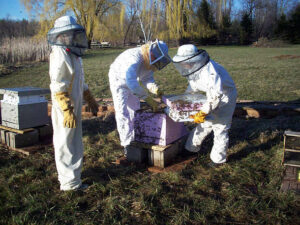I’m done with winter, especially since I have package bees coming next week and that means there’s a lot to get ready.
This post outlines some of those things to “bear in mind” as you get ready for your bees.
1. Their equipment ready?
This might mean frames assembled and with foundation, hive exteriors painted. Painted boxes should air out for a few days.
Getting the hives in place and leveled is a great idea. For Langstroth (Lang) equipment you want a gentle slope from the back to the front so that rain doesn’t run off the front and dump directly on their front entrance. That slope also allows any internal moisture to move toward the front exit.
You don’t need all frames built yet if you’re using Lang equipment—just 5 of 10, or 3 or 4 if using 8-frame boxes.
2. Your install equipment ready?
This includes a hive tool, spray bottle of sugar syrup, needle nose pliers, a screw (explained below), the camera, a rock to place atop the hive (spring storms might rip off the lid), and your protective wear.
3. Practice:
Your new bees will be confused enough when you’re installing them; it helps if you are smooth and efficient when doing so. If you’re installing into Lang equipment, simulate mounting the queen cage, and putting the box in the hive and placing on the inner cover, top cover, and feeder (if using.)
4. Installing:
One of the best videos I’ve seen on installing a package is at www.brushymountainbeefarm.com. However: he dumps them in. I usually install by:
- Putting in 5 frames (assumes 10-frame Lang equipment)
- Installing the queen (see video)
- Set the shipping box in the other half (where the frames are not)
- When you’re ready to put on the inner cover, remove the shipping box cover again. (You removed it once to pull out and check the queen)
- This approach lets you keep the bees covered until the last possible second. They’ll crawl out and snuggle the queen soon enough. If you’re forced to install in chilly weather this approach is probably best. Remember to take the box out in a day or three (depending upon weather) and add the remaining frames.
A couple additional points to note:
- Sugar syrup: A typical spring mix may be made by pouring five pounds of sugar into a clean, empty gallon jug. Add hot water and shake (you’ll have to repeat this over a few minutes) until sugar is in solution. I use this concentration in my spray bottle (I’ve never smoked during installations), as well as in feeders in the spring.
- Removing feed can: I use long-nosed pliers for pulling it out.
- A screw: We use a thin screw (or nail) to create a small tunnel through the sugar candy in the queen cage. That helps them get to her faster, but not too fast.
- No need to prove anything! The guy in the video makes a great point about wearing whatever clothing you need to feel comfortable. The more comfortable you are, the more comfortable the bees will be.
- Installing onto plastic foundation? If so, spritz it with sugar syrup to make it more enticing.
- Reduce the entrance (see video).
- Can’t install? The package can hang out in a cool (not cold) dark room for a few days. If so be sure to spritz them with sugar water a few times daily. It is helpful to place them on a newspaper as debris will fall out of the cage. You don’t want to install if it is too cold/pouring down rain…but there are ways to work around that if need be. They’ll be ok in the cage for a bit, but the quicker you get them going, the better.
- The bees in that video must be highly paid/trained…as in many of my installs over the years there were bees flying everywhere. Don’t freak out if your install doesn’t go as smoothly as the video’s. The photo shows one of mine where seemingly there were more bees outside of the box than in it.
5. Feeding:
There are plenty of opinions on whether you should do this or not. I feed my new hives in spring for as long as they will take it. Bees tend to stop taking feed once they have natural options.
6. Keep feeding if they’re taking it.
Last year a newbee I worked with fed at install, and then didn’t get back to the apiary for two weeks to see if they needed more—two weeks of cold rain. The bees had no stores built up and they starved to death. Feeding new colonies is cheap insurance for getting them off to the best start possible…especially because our weather is so variable.
Questions? Email me at [email protected]. If you’ve got dead-outs (hives from last year that died) to clean up, I can email you my tips on that.
Good luck!

